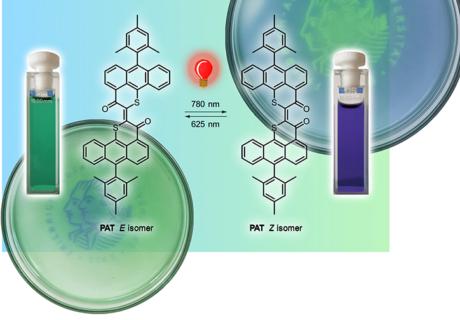Efficient molecular photoswitches
Molecular photoswitches are only nanometers in size and can change their structure and properties when exposed to light. Molecular photoswitches are of great importance in many applied areas ranging from the development of light-controlled drugs, solar energy harnessing, to the creation of optically switchable surfaces, and the exploration of smart information storage. They allow the properties of substances to be controlled from the outside with highest precision. Red light plays a special role in many applications because it is very mild, low in energy, and has great penetration depth, particularly in biological tissues. A research group at the FAU has now succeeded in synthesizing the first molecular photoswitch that can be switched exclusively with red and near infrared (NIR) light.
Previously known photoswitchable molecules could only be switched with red light in one switching direction while the reverse reaction required higher energy blue or green light. The peri-anthracenethioindigo (PAT) photoswitch developed by a team of scientists led by Professor Henry Dube from the Department of Organic Chemistry I not only reacts to red and near infrared light in both switching directions but also offers further advantages. While the stable E isomer of the PAT switch appears green in color, the second Z isomer state is quantitatively enriched by 780 nm light irradiation, giving it a blue appearance. This color change, induced by a molecular structural change, can be completely reversed by heating or reversed to 69% or 91% by irradiation with red or orange light at wavelengths of 625 nm or 590 nm, respectively.
Due to the strong color differences between the two switching state, the PAT photoswitch can be directly applied in a red-light-responsive material. The resulting transparent polystyrene polymer appears green and can be turned blue by NIR light. The written content can be erased with red or orange light. Conversely, a blue polymer can be written on with red light and erased with NIR light. Photomasks can also be used to create images, such as the FAU seal. These images are visible for a few hours and then disappear the next day.
PAT is currently the most red-shifted absorbing photoswitch available and offers entirely new possibilities with its unique properties. With ongoing research, exciting applications in various fields of chemistry, materials research, biology, and medicine can be expected.
Further information:
Publication: L. Köttner, E. Ciekalski, H. Dube,* Angew. Chem. Int. Ed. 2023, e202312955, Peri-Anthracenethioindigo: a Scaffold for Efficient All-Red-Light and Near-Infrared Molecular Photoswitching, doi: https://doi.org/10.1002/anie.202312955
Contact:
Prof. Dr. Henry Dube
Department of Chemistry and Pharmacy
Chair of Organic Chemistry I
- Phone number: +49 9131 85-65571
- Email: henry.dube@fau.de

